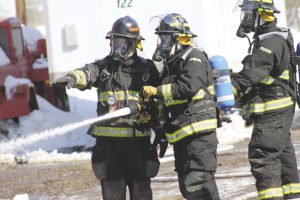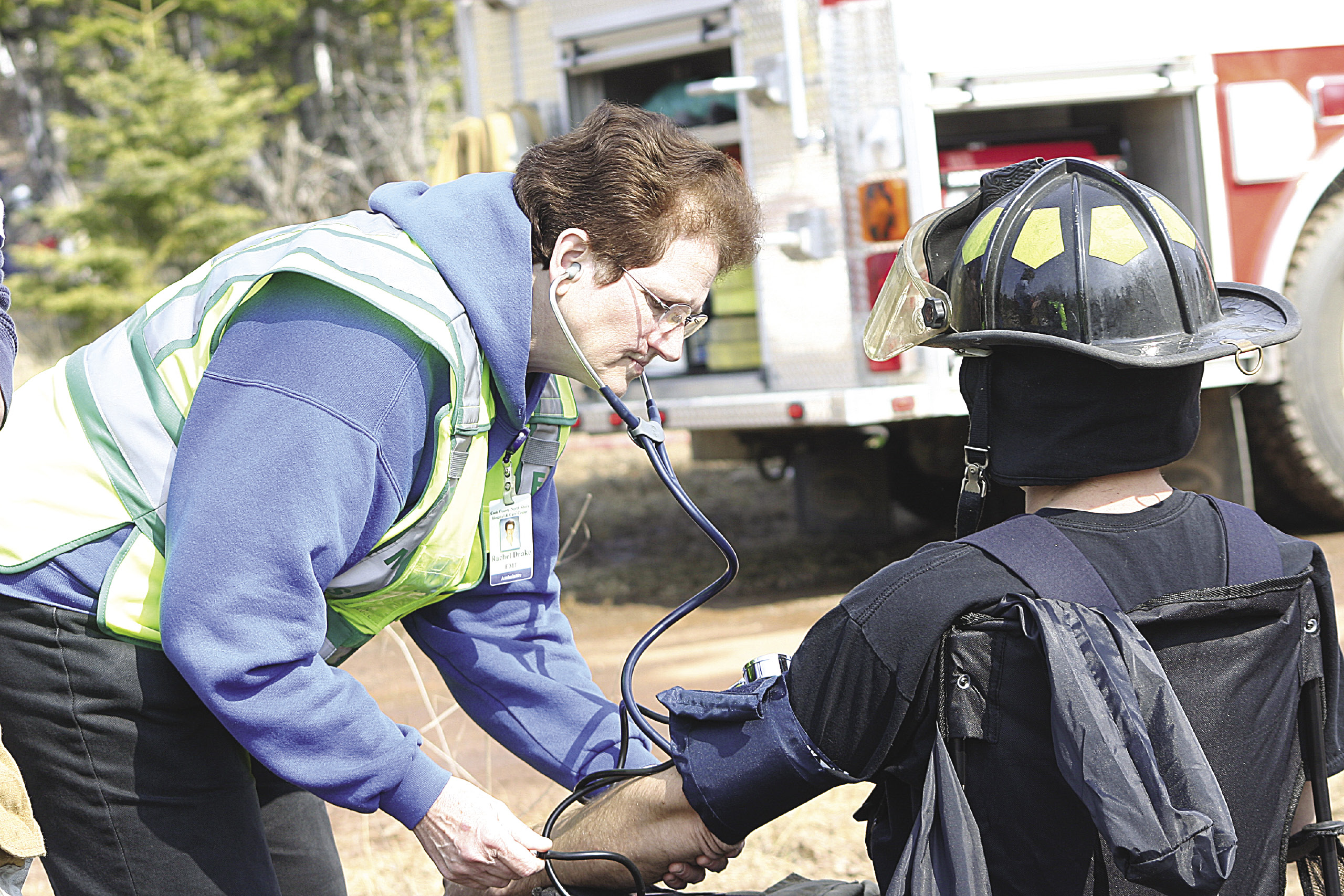All along the North Shore there are people ready at any moment to drop everything to dash to the scene of a car crash or a fire. Who are these folks who answer the page to head out in all kinds of weather to search for a missing person? Who know how to work the powerful jaws-of-life and how to deliver a baby?
BJ Kohlstedt of Lake County is an emergency medical technician and has been with Lake County Search and Rescue (SAR) for 18 years. She is now the emergency management director for Lake County.
She works with four fire departments (Two Harbors, Silver Bay, Finland and Fall Lake), one ambulance service which has stations in Two Harbors and Silver Bay, as well as three rescue squad teams. Kohlstedt says the departments function on their own; she is there to support them; to coordinate training and in times of crisis, such as “flood, fire, flu, and fiber outages.”
Kohlstedt said that the Lake County responders cover 2,000 square miles, with another 3,000 miles if water is counted. “And we do respond to emergencies on the water,” she says.
Steve DuChien of Grand Marais has been with the Cook County Ambulance for 32 years, was the Grand Marais Fire Department assistant chief for eight years and is now ambulance director for North Shore Health.

DuChien says Cook County Ambulance has three ambulances. The Grand Marais Fire Department has three fire trucks and two support vehicles. But he is quick to add that there are many more responders in the county. Cook County has three ambulance services—Cook County, based in Grand Marais, Gunflint Trail and Grand Portage. There are nine fire departments, in Schroeder, Tofte, Lutsen, Gunflint Trail, Grand Marais, Maple Hill, Colvill, Hovland and Grand Portage. And, there is also Cook County Search and Rescue.
Why so many departments? Because of the geography of Cook County. DuChien says the Cook County Ambulance alone covers about 1,200 square miles. Emergency response and medical care can be a challenge. “There are long distances—to pick up a patient and then to transport them because sometimes we can’t give them what they need,” he said.
One of the emergency responders working to meet that challenge is Rebecca Frost, who has been on the Cook County Ambulance service for 13 years. We asked her why she decided to become an emergency medical technician. She says she wanted to be on the ambulance when she was a little girl and as an adult, it means a lot to her to be able to help people.
“I’d rather know what to do in an emergency, than not know,” Frost explains. “It would be so upsetting to me to not know what to do if a family member or friend needed help.”
Wanting to help those around them is also what drives Dale and Barb Ashbee, a husband and wife team with the Neebing Fire Department, which also covers a large remote area.
The Neebing Fire Department provides services to an area of about 870 kilometers, ranging from the U.S. Canadian border to about 10 miles south of Thunder Bay, reaching about 30 miles inland. Dale, who has been the fire chief for more than 30 years, says that his department has six fire halls. The fire department has a variety of vehicles, including three pumper fire trucks, two tankers, and three “rapid attack” four-by-four units. Dale says the rapid attack vehicles are spread out within the district to be available to respond quickly and hopefully keep fires under control until the larger pumpers and tankers can arrive.
Dale says they answer about 100 calls a year—more in dry years when grass fires are more common; less when it’s been wet. But they are always ready. And it’s always on Dale’s mind. “Two or three times each spring a grass fire gets out of hand,” he says, reminding people to use caution this spring.
Barb is coordinator of the Neebing first response/pre-ambulance care team. Her responsibilities have grown over the years, says Dale, noting that most of the calls they receive now are for medical assistance. Barb notes that her involvement came naturally, because of her medical background. “When you’re a nurse in a rural area, people call you all the time anyway.”
Answering calls at all hours and in all sorts of weather, seeing people suffering and sometimes dying, can be stressful. How do responders deal with that?
Dale chuckles, “Fishing helps!”
As does remembering the calls that turned out well. Dale points to those spring fire calls as an example. “People are just frantic when you arrive. They are aghast that they’ve started a fire,” he says. “Then we arrive and we save the chicken coop, the car, the house…they are just so grateful.”
Barb reminds him of another unusual, memorable call. A horse had escaped from the barn and wandered into a nearby creek. It was found standing there, frozen in the water. Arriving to help in subzero temps, Dale recalls thinking, “This isn’t going to go well.”
But the responders were able to chop the ice and free the animal. “The owners were ecstatic,” says Dale.
“And the horse got its picture in the paper,” adds Barb.
She adds some of the most memorable calls have been unexpected births at home. “There is no better sound in the world than a baby crying!”
And Barb says for all of the calls, being able to be there when someone is frightened—when they are going through the worst moments of their lives—is what makes her stay with emergency services.

That thought is echoed by DuChien. He notes there have been many tragic calls through the years, but he chooses not to concentrate on them. Instead, he tries to remember the responses with good outcomes, which happily he says, are too many to pick just one.
Frost, like Barb, happily recalls being there to deliver a baby. “It was a perfect labor and everything worked out really well.”
She is touched that there are a few patients that have stayed in touch. One in particular because the emergency responders didn’t think the person would make it. The patient did and sometimes checks in with the rescuers. “That is a great feeling,” says Frost.
Kohlstedt recalls a 2001 search and rescue incident in which a young man named Jason was lost in an early season blizzard. He was missing for seven days and survived by holing up in a hollow white pine. And another search, in 2008, for two women lost on the Kekakabic Trail for two days also turned out well.
That search not only took several days, but covered Cook, Lake and St. Louis counties. Kohlstedt says in addition to the women being found safe, that incident led to the creation of the Northeastern Minnesota Interagency, which established a protocol for searches across county borders.
Holding onto successful incidents or calls they can laugh about helps balance the stress of the bad calls. And, Dale adds that departments usually have a pretty good “coffee klatch” to get people together to talk. But again, he says, “Fishing works best for me.”
When asked if they would encourage others to join an emergency services team, all of the responders responded with a hearty yes.
DuChien says being involved gives emergency services members ownership and it is empowering to be involved in making decisions that impact the community. And, he adds it’s an amazing way to give back to the community. “It’s truly rewarding.”
Kohlstedt agrees, “We all do a lot of volunteer things, but I think this is the most important thing I’ve ever done.”
DuChien adds that some departments pay a small stipend and the U.S. fire departments have a retirement program, but he says it’s not something you do for the money. Dale agrees, “It’s not a place you go to make a lot of money. But the rewards are there, from helping people.”
And Dale chuckles, “Just about every year I get a Christmas cake from people because I’ve helped them out.”




